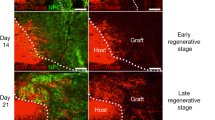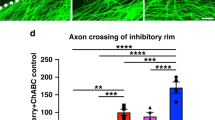Abstract
Corticospinal motor neurons (CSMN) are among the most complex CNS neurons; they control voluntary motor function and are prototypical projection neurons. In amyotrophic lateral sclerosis (ALS), both spinal motor neurons and CSMN degenerate; their damage contributes centrally to the loss of motor function in spinal cord injury. Direct investigation of CSMN is severely limited by inaccessibility in the heterogeneous cortex. Here, using new CSMN purification and culture approaches, and in vivo analyses, we report that insulin-like growth factor-1 (IGF-I) specifically enhances the extent and rate of murine CSMN axon outgrowth, mediated via the IGF-I receptor and downstream signaling pathways; this is distinct from IGF-I support of neuronal survival. In contrast, brain-derived neurotrophic factor (BDNF) enhances branching and arborization, but not axon outgrowth. These experiments define specific controls over directed differentiation of CSMN, indicate a distinct role of IGF-I in CSMN axon outgrowth during development, and might enable control over CSMN derived from neural precursors.
This is a preview of subscription content, access via your institution
Access options
Subscribe to this journal
Receive 12 print issues and online access
$209.00 per year
only $17.42 per issue
Buy this article
- Purchase on Springer Link
- Instant access to full article PDF
Prices may be subject to local taxes which are calculated during checkout








Similar content being viewed by others
References
Winhammar, J.M., Rowe, D.B., Henderson, R.D. & Kiernan, M.C. Assessment of disease progression in motor neuron disease. Lancet Neurol. 4, 229–238 (2005).
Bruijn, L.I., Miller, T.M. & Cleveland, D.W. Unraveling the mechanisms involved in motor neuron degeneration in ALS. Annu. Rev. Neurosci. 27, 723–749 (2004).
Pasinelli, P. & Brown, R.H. Molecular biology of amyotrophic lateral sclerosis: insights from genetics. Nat. Rev. Neurosci. 7, 710–723 (2006).
Rosler, K.M., Truffert, A., Hess, C.W. & Magistris, M.R. Quantification of upper motor neuron loss in amyotrophic lateral sclerosis. Clin. Neurophysiol. 111, 2208–2218 (2000).
Hains, B.C., Black, J.A. & Waxman, S.G. Primary cortical motor neurons undergo apoptosis after axotomizing spinal cord injury. J. Comp. Neurol. 462, 328–341 (2003).
Schwab, M.E. Repairing the injured spinal cord. Science 295, 1029–1031 (2002).
Chen, J., Magavi, S.S. & Macklis, J.D. Neurogenesis of corticospinal motor neurons extending spinal projections in adult mice. Proc. Natl. Acad. Sci. USA 101, 16357–16362 (2004).
Arlotta, P. et al. Neuronal subtype-specific genes that control corticospinal motor neuron development in vivo. Neuron 45, 207–221 (2005).
Molyneaux, B.J., Arlotta, P., Hirata, T., Hibi, M. & Macklis, J.D. Fezl is required for the birth and specification of corticospinal motor neurons. Neuron 47, 817–831 (2005).
Popken, G.J. et al. In vivo effects of insulin-like growth factor-I (IGF-I) on prenatal and early postnatal development of the central nervous system. Eur. J. Neurosci. 19, 2056–2068 (2004).
Wilkins, A., Chandran, S. & Compston, A. A role for oligodendrocyte-derived IGF-1 in trophic support of cortical neurons. Glia 36, 48–57 (2001).
Bondy, C.A. & Lee, W.H. Patterns of insulin-like growth factor and IGF receptor gene expression in the brain. Functional implications. Ann. NY Acad. Sci. 692, 33–43 (1993).
Bondy, C.A. Transient IGF-I gene expression during the maturation of functionally related central projection neurons. J. Neurosci. 11, 3442–3455 (1991).
O'Kusky, J.R., Ye, P. & D'Ercole, A.J. Insulin-like growth factor-I promotes neurogenesis and synaptogenesis in the hippocampal dentate gyrus during postnatal development. J. Neurosci. 20, 8435–8442 (2000).
Baker, J., Liu, J.P., Robertson, E.J. & Efstratiadis, A. Role of insulin-like growth factors in embryonic and postnatal growth. Cell 75, 73–82 (1993).
Liu, J.P., Baker, J., Perkins, A.S., Robertson, E.J. & Efstratiadis, A. Mice carrying null mutations of the genes encoding insulin-like growth factor I (Igf-1) and type 1 IGF receptor (Igf1r). Cell 75, 59–72 (1993).
Beck, K.D., Powell-Braxton, L., Widmer, H.R., Valverde, J. & Hefti, F. Igf1 gene disruption results in reduced brain size, CNS hypomyelination, and loss of hippocampal granule and striatal parvalbumin-containing neurons. Neuron 14, 717–730 (1995).
Neff, N.T. et al. Insulin-like growth factors: putative muscle-derived trophic agents that promote motoneuron survival. J. Neurobiol. 24, 1578–1588 (1993).
Dobrowolny, G. et al. Muscle expression of a local Igf-1 isoform protects motor neurons in an ALS mouse model. J. Cell Biol. 168, 193–199 (2005).
Kaspar, B.K., Llado, J., Sherkat, N., Rothstein, J.D. & Gage, F.H. Retrograde viral delivery of IGF-1 prolongs survival in a mouse ALS model. Science 301, 839–842 (2003).
Clemmons, D.R. et al. Role of insulin-like growth factor binding proteins in the control of IGF actions. Prog. Growth Factor Res. 6, 357–366 (1995).
Giehl, K.M. Trophic dependencies of rodent corticospinal neurons. Rev. Neurosci. 12, 79–94 (2001).
Harrington, A.W. et al. Secreted proNGF is a pathophysiological death-inducing ligand after adult CNS injury. Proc. Natl. Acad. Sci. USA 101, 6226–6230 (2004).
Junger, H. & Varon, S. Neurotrophin-4 (NT-4) and glial cell line-derived neurotrophic factor (GDNF) promote the survival of corticospinal motor neurons of neonatal rats in vitro. Brain Res. 762, 56–60 (1997).
Catapano, L.A., Arlotta, P., Cage, T.A. & Macklis, J.D. Stage-specific and opposing roles of BDNF, NT-3 and bFGF in differentiation of purified callosal projection neurons toward cellular repair of complex circuitry. Eur. J. Neurosci. 19, 2421–2434 (2004).
Catapano, L.A., Arnold, M.W., Perez, F.A. & Macklis, J.D. Specific neurotrophic factors support the survival of cortical projection neurons at distinct stages of development. J. Neurosci. 21, 8863–8872 (2001).
Hevner, R.F. et al. Beyond laminar fate: toward a molecular classification of cortical projection/pyramidal neurons. Dev. Neurosci. 25, 139–151 (2003).
Frantz, G.D., Bohner, A.P., Akers, R.M. & McConnell, S.K. Regulation of the POU domain gene SCIP during cerebral cortical development. J. Neurosci. 14, 472–485 (1994).
Giehl, K.M. et al. Endogenous brain-derived neurotrophic factor and neurotrophin-3 antagonistically regulate survival of axotomized corticospinal neurons in vivo. J. Neurosci. 21, 3492–3502 (2001).
Deckwerth, T.L. et al. BAX is required for neuronal death after trophic factor deprivation and during development. Neuron 17, 401–411 (1996).
David, S. & Aguayo, A.J. Axonal elongation into peripheral nervous system “bridges” after central nervous system injury in adult rats. Science 214, 931–933 (1981).
Goldberg, J.L. & Barres, B.A. Neuronal regeneration: extending axons from bench to brain. Curr. Biol. 8, R310–R312 (1998).
Li, S.L., Kato, J., Paz, I.B., Kasuya, J. & Fujita-Yamaguchi, Y. Two new monoclonal antibodies against the alpha subunit of the human insulin-like growth factor-I receptor. Biochem. Biophys. Res. Commun. 196, 92–98 (1993).
Pietrzkowski, Z., Wernicke, D., Porcu, P., Jameson, B.A. & Baserga, R. Inhibition of cellular proliferation by peptide analogues of insulin-like growth factor 1. Cancer Res. 52, 6447–6451 (1992).
Goldberg, J.L. et al. Retinal ganglion cells do not extend axons by default: promotion by neurotrophic signaling and electrical activity. Neuron 33, 689–702 (2002).
Liu, R.Y. & Snider, W.D. Different signaling pathways mediate regenerative versus developmental sensory axon growth. J. Neurosci. 21, RC164 (2001).
Fryer, R.H. et al. Developmental and mature expression of full-length and truncated TrkB receptors in the rat forebrain. J. Comp. Neurol. 374, 21–40 (1996).
Huang, E.J. et al. Expression of Trk receptors in the developing mouse trigeminal ganglion: in vivo evidence for NT-3 activation of TrkA and TrkB in addition to TrkC. Development 126, 2191–2203 (1999).
Bloch-Gallego, E. et al. Survival in vitro of motoneurons identified or purified by novel antibody-based methods is selectively enhanced by muscle-derived factors. Development 111, 221–232 (1991).
Meyer-Franke, A., Kaplan, M.R., Pfrieger, F.W. & Barres, B.A. Characterization of the signaling interactions that promote the survival and growth of developing retinal ganglion cells in culture. Neuron 15, 805–819 (1995).
Clement, A.M. et al. Wild-type nonneuronal cells extend survival of SOD1 mutant motor neurons in ALS mice. Science 302, 113–117 (2003).
Rotwein, P., Burgess, S.K., Milbrandt, J.D. & Krause, J.E. Differential expression of insulin-like growth factor genes in rat central nervous system. Proc. Natl. Acad. Sci. USA 85, 265–269 (1988).
Sosa, L. et al. IGF-1 receptor is essential for the establishment of hippocampal neuronal polarity. Nat. Neurosci. 9, 993–995 (2006).
Liu, Y. et al. Ryk-mediated Wnt repulsion regulates posterior-directed growth of corticospinal tract. Nat. Neurosci. 8, 1151–1159 (2005).
Schwab, M.E. Nogo and axon regeneration. Curr. Opin. Neurobiol. 14, 118–124 (2004).
A double-blind placebo-controlled clinical trial of subcutaneous recombinant human ciliary neurotrophic factor (rHCNTF) in amyotrophic lateral sclerosis. ALS CNTF Treatment Study Group. Neurology 46, 1244–1249 (1996).
A controlled trial of recombinant methionyl human BDNF in ALS: the BDNF Study Group (Phase III) Neurology, 52, 1427–1433 (1999).
Borasio, G.D. et al. A placebo-controlled trial of insulin-like growth factor-I in amyotrophic lateral sclerosis. European ALS/IGF-I Study Group. Neurology 51, 583–586 (1998).
Lai, E.C. et al. Effect of recombinant human insulin-like growth factor-I on progression of ALS. A placebo-controlled study. The North America ALS/IGF-I Study Group. Neurology 49, 1621–1630 (1997).
Horch, H.W. & Katz, L.C. BDNF release from single cells elicits local dendritic growth in nearby neurons. Nat. Neurosci. 5, 1177–1184 (2002).
Acknowledgements
We thank B. Molyneaux for help and advice on neonatal surgery; L. Catapano and J. Chen for help with neuron isolation; D. Dombkowski for expert advice and optimization of FACS methods; D. Scadden for generous access to tissue culture facilities near the FACS facility; N. Kishi for help with Sholl analysis; J. Emsley for advice on statistical analysis; L. Reichardt, D. Kaplan, T. Jessell and M. Leid for gifts of antibodies; F. Briggs, A. Eswar and A. Palmer for technical assistance; A. Chandawarkar and J. Nagurney for help with blinded data analysis and immunocytochemistry; T. Jakobs for help with live imaging; and J. Emsley, P. Arlotta, S. Sohur, J. Menezes and other members of the Macklis lab for critical reading of the manuscript. This work was supported by grants from the US National Institutes of Health (NS49553, NS45523 and NS41590) and the ALS Association (to J.D.M.). P.H.O. was supported by a Harvard Center for Neurodegeneration and Repair Postdoctoral Fellowship.
Author information
Authors and Affiliations
Contributions
This study was jointly designed by P.H.Ö. and J.D.M.; experiments were performed by P.H.Ö.; P.H.Ö. and J.D.M. jointly analyzed and interpreted data and jointly wrote the paper.
Corresponding author
Ethics declarations
Competing interests
The authors declare no competing financial interests.
Supplementary information
Supplementary Fig. 1
The effects of IGF-I are specific to axon extension. (PDF 961 kb)
Supplementary Fig. 2
Other growth factors do not substantially affect CSMN morphology. (PDF 1221 kb)
Supplementary Fig. 3
IGF-I receptor is expressed in CSMN axons, anti-IGF-IRα, and anti-TrkB antibodies binds to CSMN axons in vivo, and CSMN death does not occur following antibody application. (PDF 1362 kb)
Supplementary Video 1
Local application of IGF-I via placement of a single IGF-I-coated bead near CSMN cell body/axon hillock results in immediate and dramatic effects on the rate of CSMN axon outgrowth. (MOV 18131 kb)
Supplementary Video 2
In the presence of control beads, coated with BSA or PBS, the rate of axon outgrowth is quite slow. (MOV 24296 kb)
Supplementary Video 3
BDNF-coated beads induce immediate and local branching at the site of placement. (MOV 12508 kb)
Rights and permissions
About this article
Cite this article
Özdinler, P., Macklis, J. IGF-I specifically enhances axon outgrowth of corticospinal motor neurons. Nat Neurosci 9, 1371–1381 (2006). https://doi.org/10.1038/nn1789
Received:
Accepted:
Published:
Issue Date:
DOI: https://doi.org/10.1038/nn1789
This article is cited by
-
Osteopontin enhances the effect of treadmill training and promotes functional recovery after spinal cord injury
Molecular Biomedicine (2023)
-
Astroglial exosome HepaCAM signaling and ApoE antagonization coordinates early postnatal cortical pyramidal neuronal axon growth and dendritic spine formation
Nature Communications (2023)
-
Blocking insulin-like growth factor 1 receptor signaling pathway inhibits neuromuscular junction regeneration after botulinum toxin-A treatment
Cell Death & Disease (2023)
-
The neurobiology of insulin-like growth factor I: From neuroprotection to modulation of brain states
Molecular Psychiatry (2023)
-
IGF-1 Combined with OPN Promotes Neuronal Axon Growth in Vitro Through the IGF-1R/Akt/mTOR Signaling Pathway in Lipid Rafts
Neurochemical Research (2023)



